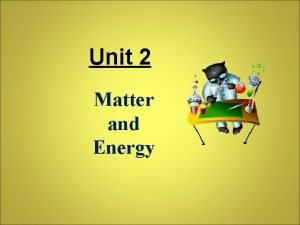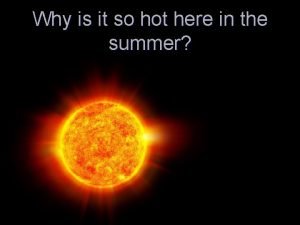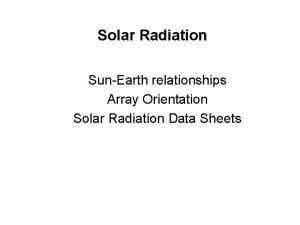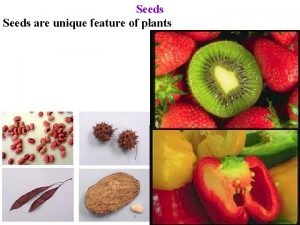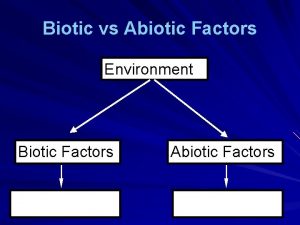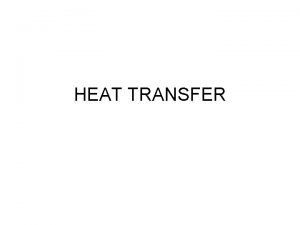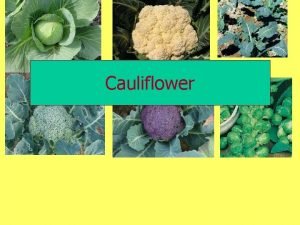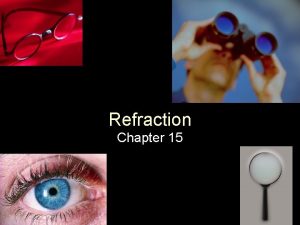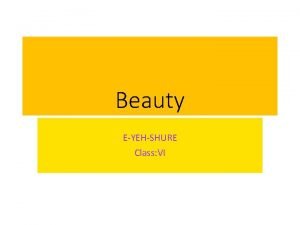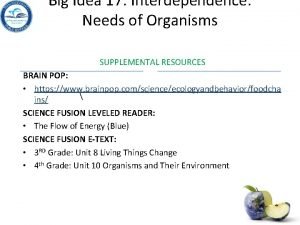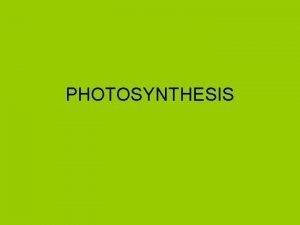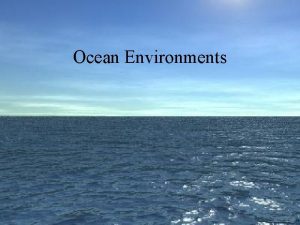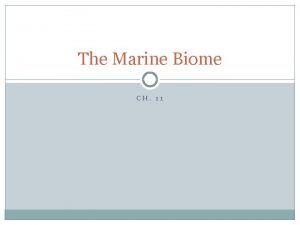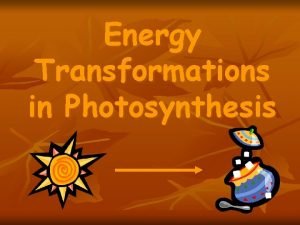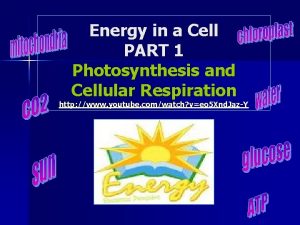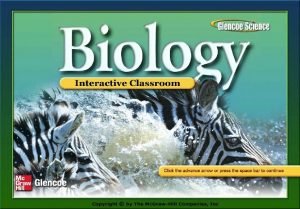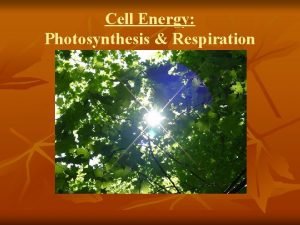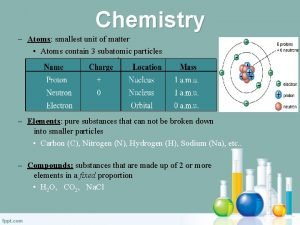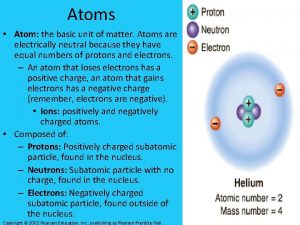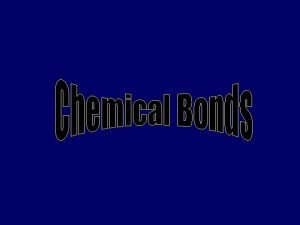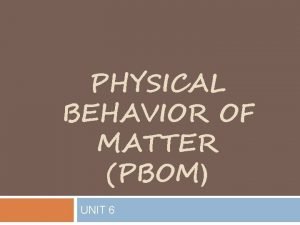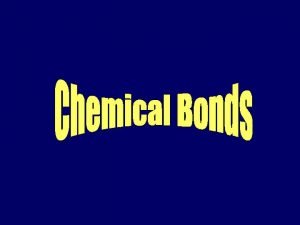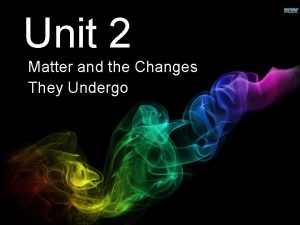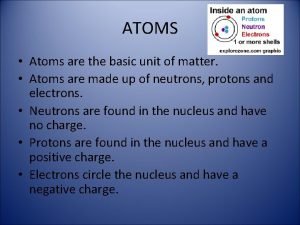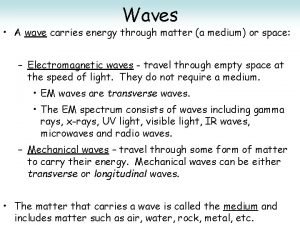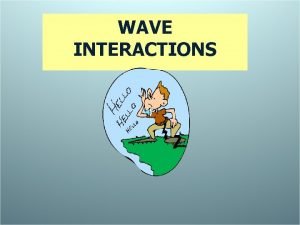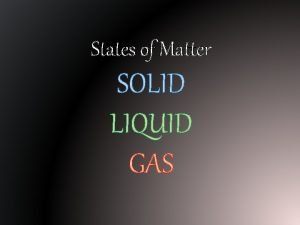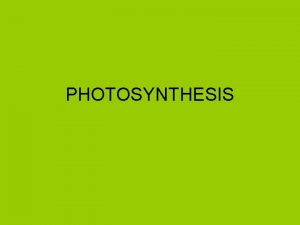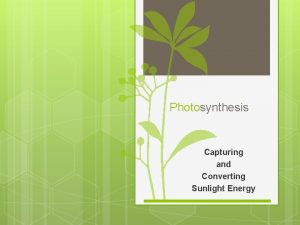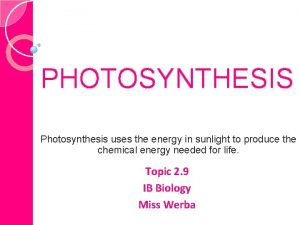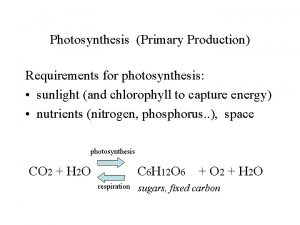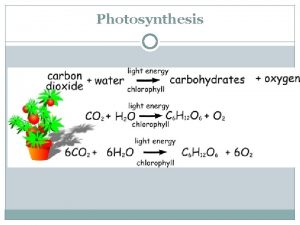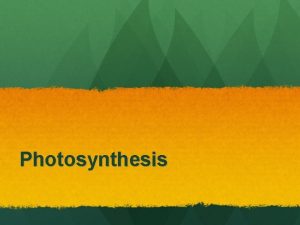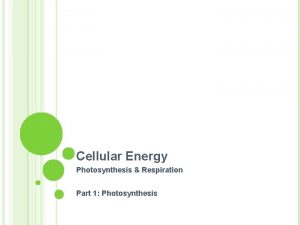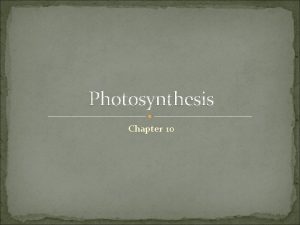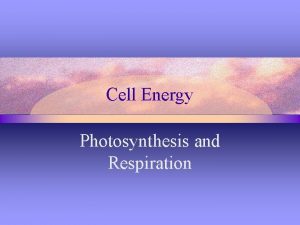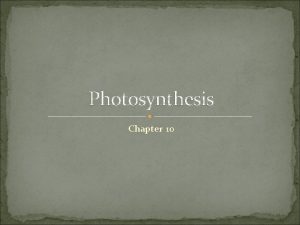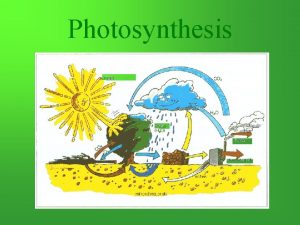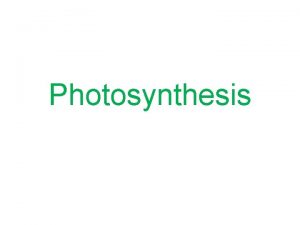UNIT 5 PHOTOSYNTHESIS ENERGY MATTER Energy In Sunlight













































- Slides: 45

UNIT 5 PHOTOSYNTHESIS

ENERGY & MATTER Energy In – Sunlight Out – Bonds between Biomolecules Matter In – H 2 O(Soil; van Helmont), CO 2 (Air), Inorganic – No Carbon Organic - Carbon Out O 2; Other Biomolecules (Sugars, ETC. )

QUESTION… Where does photosynthesis occur?

ANATOMY OF PHOTOSYNTHESIS Leaf Major site of photosynthesis; although can occur all over Plant Mesophyl – tissue in interior of leaf Stomata – Pores; take in CO 2 release O 2 Vein – Transport water absorbed by roots Chloroplasts Organelle of photosynthesis 2 membranes; Thylakoids – houses light absorbing pigments thylakoid sacs are stacked – named Granum Stroma & thylakoid space


CHLOROPHYLL & PIGMENT Chloroplasts are BOUND DIRECTLY to thylakoid membrane Provide thylakoid with its “green” color What is a pigment? Substances that absorb visible light - Different pigments absorb different wavelegnths of light Light can be reflected, transmitted, absorbed Whiteboard? Tabletop? Leaf?


PHOTOSYNTHESIS Complex set of reactions that convert light energy into chemical energy. Three types of Energy Conversions 1. Light absorption 2. Conversion of Light Energy into Chemical Energy 3. Storage of Chemical Energy as sugars 1 & 2 make up what we call the - Light (dependent) Reactions - Convert to energy; Photo portion 3 is a process known as - Light Independent (Dark) Reactions AKA - The Calvin Cycle Build biomolecules


DIAGRAM – LIGHT REACTION Two clusters of light absorbing pigments: Photosystem II Photosystem I Named in order discovered Regions of Concentrated Chlorophyll What is evidence that red and blue light is absorbed in plants? In absorbing light, what change does this cause? Energized electrons leave chlorophyll Move down proteins by Electron Transport Chain

Any time molecule ACCEPTS electrons Reduced or Oxidized? REDUCED Oxidation Is Loss (e-) Reduction Is Gain (e-) Rapid shift down proteins: Reduced Oxidized Reduced… REDOX REACTION This process is how electrons move down proteins of Electron Transport Chain

OVERVIEW QUESTIONS What do we know about the structure of a leaf? What are the names of the reactions that occur during photosynthesis? How would you describe what occurs in the Light Reactions? How would you describe what occurs in the Light Independent Reactions/Calvin Cycle?

When pigment molecule absorbs a photon, photon is passed from protein to protein Electron Transport Chain Think of “The Wave” Series of protein molecules embedded in thylakoid membrane @ Each protein Redox reactions – pass e- Small amount of energy is released from each Redox reaction Certain proteins serve only to pass e. Others have specific function

When e- passes through a specific protein in ETC Causes the ACTIVE TRANSPORT of H+ into Thylakoid space Like PSII & PSI, proteins in ETC are embedded in thylakoid membrane Surplus of protons (H+) develop within the interior of Thylakoid – Set up HUGE Concentration Gradient More H+ on the interior than on the exterior

Is the movement of H + this active or passive transport? Do we need a transport protein? Is this energy requiring or energy releasing? How does this energy change our system? Helps form ATP!!!

ATP Known as Adenosine Triphosphate Structure: The process of using energy – running metabolism Break ATP into Adenosine Diphosphate Structure: Run reactions for energy – Which is energy storing? L R or R L Energy releasing?

This whole process has a specific name: Movement of protons within the thylakoid space due to the redox reactions that move electrons down the Electron Transport Chain H+ Gradient develops Ion Channel – ATP Synthase moves H+ out of the thylakoid Provides energy for the formation of ATP from ADP + Energy Chemiosmosis

PHOTOSYSTEM I 95% of what we know about PSII are the same for PSI Photons hit chlorophyll A & B Excite electrons to a higher energy state Electrons are accepted by proteins in ETC, “jump” from protein to protein Cause influx of H+ into thylakoid space Will help “power” ATP Synthase

5 % DIFFERENCE 1. Electrons from PS II are OXIDIZING PS I Refilling e- lost at PS I Photons hit PSI, excite process 2. Electrons from PSI reduce NADP+ is the final “resting place” – of e • Final electron acceptor VERY High affinity for electrons

PHOTOSYSTEM I At end of the reaction: NADP+ + H+ + 2 e- _____> NADPH is known as a Coenzyeme “Electron shuttle” Accept electrons – transfer to different source Pick up electrons, transfer them to Calvin Cycle, return to Light Reaction

PHOTOLYSIS Specific enzyme is attached to PSII that breaks H 2 O down Occurs simultaneously as photons are hitting PSII Light splits H 2 O 4 H+ 4 e O 2 What are the functions of all of the above?


3 CO 2 3 ADP (3) 5 -Carbon (3) Ribulose Bi. Phosphate Ru. BP 6 -Carbon Intermediate - Unstable 3 ATP (6) 3 -Carbon (5) 3 -Carbon PGAL 6 ATP 6 ADP (6) 3 -Carbon PGAL (1) 3 - Carbon PGAL 6 NADPH 6 NADP+


(3) 5 -Carbon Ribulose 6 -Carbon Intermediat e - Unstable Bi. Phosphate PGA (6) 3 Carbon PGA (5) 3 Carbon PGAL (6) 3 Carbon PGAL

GOALS 1. Compare and contrast the advantages and disadvantages of the following: C 3, C 4 & CAM 2. Explain how limiting factors (CO 2, Light, H 2 O) may affect photosynthesis and be able to draw/explain graphs that detail various limiting factors 3. Predict how photosynthesis will change when environmental factors change

ENVIRONMENTAL EFFECTS OF PHOTOSYNTHESIS Goal is to examine various environmental effects that implications on the rate of photosynthesis

RETURN TO ANATOMY How do plants move CO 2 & H 20 in and O 2 out of the plant? Stomata pores on the underside Exchange CO 2, H 20 and O 2 Has the ability to close - Guard Cells


PHOTORESPIRATION When RUBISCO binds to O 2 instead of CO 2 Although RUBISCO is efficient of binding inorganic carbon (CO 2) – it also attracts O 2 to binding site O 2 and CO 2 have SIMILAR SHAPE Non-specific active site 4 x higher binding affinity for CO 2 than O 2 Running photorespiration lowers photosynthetic output Takes in O 2, Releases CO 2 Only one PGAL per cycle Half as efficient!

PGA

PHOTORESPIRATION – EVOLUTIONARY RELIC At point of origin of photorespiration, there was NO O 2 in the atmosphere Why should we consider this? 2. 5 to 3 BILLION years ago – environment was almost all CO 2 Unnecessary for plants to worry about O 2 binding Not much O 2 in the atmosphere, no need for enzyme to differentiate between O 2 and CO 2 Inefficient? Adaptation to address the inefficiency? C 4

C 3 STRUCTURE VS. C 4 STRUCTURE

C 4 What do we need to address the inefficiency of Rubisco? A different enzyme to avoid O 2 binding. We got it – PEP Carboxylase Fixes CO 2 to 3 C structure PEP to form 4 C OAA - Oxaloacetic Acid Various Enzymes convert OAA into 4 C Malic Acid “sneaks” CO 2 into Bundle Sheath Cells CO 2 Breaks off – Run Calvin Cycle as Normal

C 4 EXTREMELY IMPORTANT THE BUNDLE SHEETH CELLS ARE IMPERMEABLE TO CO 2!! Why is this important? Carbons are really stow-aways Move 4 th Carbon into bundle sheath cell Separate from Malate – Malate leaves – NOT CO 2 Once in, cannot leave Thus C 4 concentrates CO 2 in Sheath Cells


Examples of C 4 Plants: Rice, Soybeans, Sugar Cane, Corn Warm Season Grasses

C 4 ADVANTAGE C 4 more effective in High Temperatures or High O 2 environments What happens in environments w/ high temp. ? Stomates Close Mesophyll cells “pump” CO 2 into the bundle sheath cells, Continuously keeping CO 2 concentration high Avoid possibility for Photorespiration C 4 plants are successful in hotter/drier climates –

C 4 DISADVANTAGE More ATP required to convert 3 -Carbon in Sheath cell back into PEP Spend extra energy to run this reaction. Need PEP to bind CO 2 to OAA Must spend energy to convert pyruvate into PEP The question is – How does the carbon fixation of C 3 differ from C 4? (aside from process…)

LOCATION, LOCATION!!!

CAM – Crassulacean Acid Metabolism Adaptation for intense arid conditions Many succulent plants, cacti, pineapples, Jade Water Plants open stomata at night Take conservation adaptation up CO 2 & incorporate into organic acids Close stomata during the day Prevent massive water loss But, no CO 2 can enter


CAM During the day, when light is plentiful CO 2 is released from Organic Acids Breaks off of Malic Acid CO 2 moves to Calvin Cycle Organic Acid returns to bind more CO 2 at night So, how do C 4 and CAM pathways of carbon fixation differ?

C 4 Separates Calvin Cycle in LOCATION CAM separates Calvin Cycle in TIME

 Flow energy review
Flow energy review Photosynthesis transforms light energy into chemical energy
Photosynthesis transforms light energy into chemical energy Unit 2 matter and energy
Unit 2 matter and energy Earth's revolution
Earth's revolution Thank you solar system
Thank you solar system Hours of sunlight map
Hours of sunlight map Seed maturation
Seed maturation Siklus hidup produk sunlight
Siklus hidup produk sunlight Is mud abiotic or biotic
Is mud abiotic or biotic Full sunlight lux
Full sunlight lux How does heat move
How does heat move Riceyness in cauliflower
Riceyness in cauliflower Raindrops sunlight and refraction lyrics
Raindrops sunlight and refraction lyrics Poem beauty
Poem beauty Plants getting sunlight
Plants getting sunlight Sunligj
Sunligj Buckshot barnacle
Buckshot barnacle How much sunlight does the marine biome get
How much sunlight does the marine biome get Is mud abiotic or biotic
Is mud abiotic or biotic Classification of matter section 1 composition of matter
Classification of matter section 1 composition of matter Gray matter in the brain
Gray matter in the brain Section 1 composition of matter
Section 1 composition of matter Chapter 2 section 1 classifying matter answers
Chapter 2 section 1 classifying matter answers Optic tract
Optic tract Section 1 composition of matter chapter 15 answer key
Section 1 composition of matter chapter 15 answer key Gray matter and white matter
Gray matter and white matter Matter
Matter Unit 10, unit 10 review tests, unit 10 general test
Unit 10, unit 10 review tests, unit 10 general test Energy transformations in photosynthesis
Energy transformations in photosynthesis Photosynthesis energy transformation
Photosynthesis energy transformation Cellular energy section 2 photosynthesis answer key
Cellular energy section 2 photosynthesis answer key Chapter 6 cell energy photosynthesis and respiration
Chapter 6 cell energy photosynthesis and respiration Are atoms the smallest unit of matter
Are atoms the smallest unit of matter What is the basic unit of matter?
What is the basic unit of matter? The smallest unit of an element
The smallest unit of an element Physical behavior of matter
Physical behavior of matter What is the basic unit of matter
What is the basic unit of matter What is the smallest unit of a metallic bond
What is the smallest unit of a metallic bond Unit 1 materials formulating matter
Unit 1 materials formulating matter Unit 2 matter and change
Unit 2 matter and change What is the basic unit of matter
What is the basic unit of matter Energy energy transfer and general energy analysis
Energy energy transfer and general energy analysis Energy energy transfer and general energy analysis
Energy energy transfer and general energy analysis Mechanical wave energy
Mechanical wave energy Waves transfer energy without transferring matter
Waves transfer energy without transferring matter Thermal energy states of matter
Thermal energy states of matter


